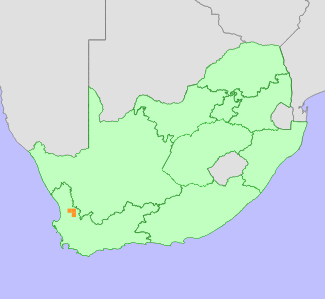|
Scientific Name | Serruria leipoldtii E.Phillips & Hutch. |
Higher Classification | Dicotyledons |
Family | PROTEACEAE |
Common Names | Leipoldt's Spiderhead (e) |
National Status |
Status and Criteria | Near Threatened D2 |
Assessment Date | 2020/04/14 |
Assessor(s) | A.G. Rebelo, H. Mtshali & L. von Staden |
Justification | Serruria leipoldtii is a localized species, with an extent of occurrence (EOO) of 141 km², and area of occupancy (AOO) of 92 km². It is known from six locations and is potentially threatened by competition from alien invasive plants, which are already present in low densities at three of its locations. Therefore it nearly meets the criteria thresholds for Vulnerable under criterion B and D and is listed as Near Threatened. |
Distribution |
Endemism | South African endemic |
Provincial distribution | Western Cape |
Range | This species is endemic to the Northern Cederberg Mountains, in the Western Cape Province, South Africa. |
Habitat and Ecology |
Major system | Terrestrial |
Major habitats | Cederberg Sandstone Fynbos |
Description | It occurs in dry sandstone fynbos, at altitudes of 800-1100 m. It is a long-lived species, and survives fires by resprouting from underground boles or rootstocks. Seeds are released after ripening, and dispersed by ants to their underground nests, where they are protected from predation and fire. It is pollinated by insects. |
Threats |
| At least 5% of Serruria leipoldtii's habitat is already irreversibly modified, and there is a slow ongoing sporadic loss of habitat (1% recorded between 1990 and 2014). On flats, particularly outside the protected area (Eslebank plateau and Heuningvlei) loss of habitat is due to crop cultivation mainly for rooibos tea. This species appears to persist in spite of this impact, but it is potentially vulnerable to increasing densities of alien invasive plants in places. |
Population |
Although a resprouter with high persistence, the majority of subpopulations are small and are usually isolated. Only one large subpopulation with more than 1 000 plants is known. The population is currently stable, but likely to decline due to habitat loss and degradation in future.
|
Population trend | Stable |
Conservation |
| It is conserved within the Cederberg Wilderness Area. |
Assessment History |
Taxon assessed |
Status and Criteria |
Citation/Red List version | | Serruria leipoldtii E.Phillips & Hutch. | NT D2 | Raimondo et al. (2009) | | Serruria leipoldtii E.Phillips & Hutch. | Rare | Hilton-Taylor (1996) | | Serruria leipoldtii E.Phillips & Hutch. | Rare | Hall et al. (1980) | |
Bibliography |
Goldblatt, P. and Manning, J.C. 2000. Cape Plants: A conspectus of the Cape Flora of South Africa. Strelitzia 9. National Botanical Institute, Cape Town.
Hall, A.V., De Winter, M., De Winter, B. and Van Oosterhout, S.A.M. 1980. Threatened plants of southern Africa. South African National Scienctific Programmes Report 45. CSIR, Pretoria.
Hilton-Taylor, C. 1996. Red data list of southern African plants. Strelitzia 4. South African National Botanical Institute, Pretoria.
Manning, J.C. and Goldblatt, P. 2012. Plants of the Greater Cape Floristic Region 1: The Core Cape Flora. Strelitzia 29. South African National Biodiversity Institute, Pretoria.
Raimondo, D., von Staden, L., Foden, W., Victor, J.E., Helme, N.A., Turner, R.C., Kamundi, D.A. and Manyama, P.A. 2009. Red List of South African Plants. Strelitzia 25. South African National Biodiversity Institute, Pretoria.
Rebelo, T. 2001. Sasol Proteas: A field guide to the proteas of southern Africa. (2nd ed.). Fernwood Press, Vlaeberg, Cape Town.
|
Citation |
| Rebelo, A.G., Mtshali, H. & von Staden, L. 2020. Serruria leipoldtii E.Phillips & Hutch. National Assessment: Red List of South African Plants version . Accessed on 2025/05/31 |
 Comment on this assessment
Comment on this assessment

